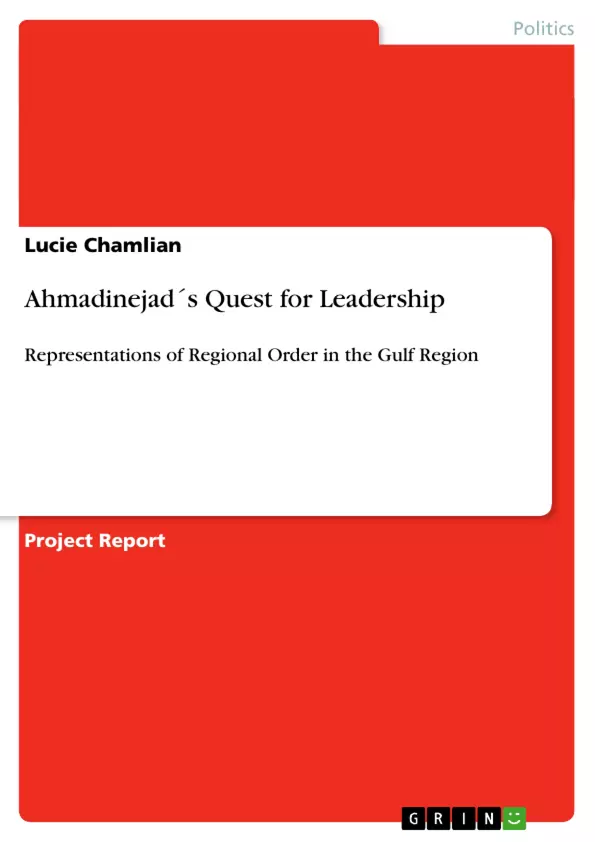Is Iran a `regional leading power´? How can leadership be conceptualised? How can its impact be measured? While leadership has often been equated with the mere possession of power capabilities, this study emphasises the social and ideational dimensions of leadership, taking recourse to symbolic interactionism, constructivism and reflexive-interpretative methodology. Discourses can be regarded as dynamic arenas in which claims to leadership are articulated, legitimised but also contested. Therefore, they are a commensurate means to grasp potential leadership-relations as well as to identify continuity or change in such relations. A starting point to assess the scope of leadership is to compare the representations of regional order of the potential leader and followers. If they are shared between the two parties and mostly shaped by the potential leader, leadership may be effective at least on a normative level. In the light of the nuclear conflict, which makes this study highly topical, following question is raised: To what extent are Ahmadinejad´s visions of regional order shared by his political counterparts in the Gulf region?
Inhaltsverzeichnis (Table of Contents)
- I. Introduction
- A. Historical Background
- B. Research Question
- II. State of the Art
- III. On Power and Leadership
- A. Competing Views of Power
- B. How to Convert Potential Power into Leadership
- C. Implications for the Study of Regional Leading Powers
- IV. Discourse Analysis and Leadership
- A. Discourse as an Analytical Tool
- 1. Discourse and Foreign Policy
- 2. Discourse and Security
- 3. Discourse and Leadership
- B. Operationalisation of Discourse
- 1. Reliance on Elite Discourse
- 2. Data Record
- 3. Key Words
- A. Discourse as an Analytical Tool
- V. Iran's Discursive Construction of Leadership
- A. Representation of a Repressed Leadership
- 1. Framed Legitimacy of Nuclear Activities
- 2. Resistance Against Perceived Injustice
- B. Representation of an Alternative Regional Order
- 1. Narrative of a Responsible Neighbour
- 2. Construction of Common Interests and Enemies
- 3. Iranian Entrepreunarialism in the Security Field
- A. Representation of a Repressed Leadership
- VI. Gulf States' Reception of Iranian Ambitions
- A. Linking the Nuclear Issue to Regional Security
- 1. Common Threat Perception
- 2. Desiderata of Peace, Stability and Security
- B. Limits of Iranian Leadership
- 1. Counter-Initiatives as Immediate Response
- 2. Caution on Iranian Initiatives
- 3. Further Sources of Distrust
- A. Linking the Nuclear Issue to Regional Security
- VII. Empirical Results
Zielsetzung und Themenschwerpunkte (Objectives and Key Themes)
This work examines the scope of Iranian leadership in the Gulf region, particularly in the context of Iran's nuclear ambitions. It investigates how Iran presents itself as a regional leader and how this perception is received by the Gulf Cooperation Council (GCC) states. The study employs a constructivist approach, analyzing the discursive strategies utilized by both Iran and the GCC to construct their respective identities and define their interests in the region. The key themes explored in the study include:- Iran's discursive construction of leadership, including its claims to legitimacy and its framing of nuclear activities.
- Iran's vision for a regional order and its efforts to establish itself as a responsible neighbor.
- The GCC states' reception of Iran's ambitions, particularly their concerns regarding Iran's nuclear program and their perception of Iran's role in regional security.
- The limits of Iranian leadership and the factors hindering its ability to effectively lead the region.
- The significance of discursive analysis in understanding the dynamics of regional power and leadership in the Gulf region.
Zusammenfassung der Kapitel (Chapter Summaries)
The introduction provides a historical background to the Gulf region and outlines the research question: How does Iran discursively construct its leadership in the region, and how is this construction received by the Gulf states?
Chapter II reviews the existing literature on regional leading powers, particularly focusing on the roles of power and leadership in the context of international relations.
Chapter III explores competing views of power and analyzes how potential power can be converted into leadership. It also discusses the implications of this framework for understanding regional leading powers.
Chapter IV provides a detailed explanation of discourse analysis as a research methodology, outlining its application in the study of foreign policy, security, and leadership. It also presents the specific operationalization of discourse analysis in the present study, including the reliance on elite discourse, data records, and key words.
Chapter V examines Iran's discursive construction of leadership, focusing on how Iran represents itself as a repressed leadership facing injustice and presents its nuclear activities as legitimate. This chapter also analyzes Iran's vision for an alternative regional order, emphasizing its narrative of a responsible neighbor, its construction of shared interests and enemies, and its entrepreneurial role in the security field.
Chapter VI investigates the Gulf states' reception of Iranian ambitions. It analyzes how the GCC states link Iran's nuclear activities to regional security, outlining their common threat perceptions and their desiderata of peace, stability, and security. The chapter also explores the limitations of Iranian leadership, discussing the GCC's counter-initiatives, their cautious approach to Iranian initiatives, and further sources of distrust.
Schlüsselwörter (Keywords)
The primary focus of this work is on regional leading powers and the role of discourse in shaping their perceptions and interactions. Key terms and concepts include: regional leadership, Iran, Gulf Cooperation Council (GCC), nuclear ambitions, discursive construction, constructivism, post-structuralism, power, identity, security, and regional order. The study highlights the importance of analyzing how language and narratives shape international relations and contribute to understanding the complex dynamics in the Gulf region.- Quote paper
- Lucie Chamlian (Author), 2009, Ahmadinejad´s Quest for Leadership, Munich, GRIN Verlag, https://www.grin.com/document/132214



